Earlier this year, NEAR announced the Blockchain Operating System. An industry-first category, the BOS is a common layer for browsing and discovering open web experiences, compatible with any blockchain.
A real alternative to the Operating Systems of centralized platforms, the BOS is now live at near.org. As a blockchain operating system for an open web, the BOS is accessible to everyone, not just web3 natives. And it makes Web3 and Web2 easier than ever to access and navigate for users and developers alike.
With the BOS, you no longer have to choose between decentralization and discoverability. Devs and users get the best of both worlds, whether they are new to Web3 experiences and want to play around, or developers looking to build an open web.
Seamless Web2 style onboarding for Web3
When entering Web3, users want an easy Web2-style onboarding experience. Until the BOS, this just wasn’t possible.
With FastAuth, BOS users get to experience a simple and seamless Web2 style onboarding. Users can get started quickly by creating an account for any app on the BOS — without the need for crypto.
By putting the user experience at the center, FastAuth creates a familiar style of onboarding experience, in which users can create a free account with biometrics, phone prompts, and an email address. Users can now quickly interact with an app without having to remember long seed phrases and other difficult passwords.
This will help dramatically move Web2 users into the Web3 space with ease.
Developers are empowered to start and build quickly
The BOS isn’t just built for Web3 natives. It’s designed for any developer interested in open-source and decentralization.
To make Web3 app development fast and easy, the BOS offers a comprehensive set of tools and capabilities to get developers started quickly. These developer enablement tools and capabilities make it possible for developers to quickly build composable apps for the open web, as well as build complete projects using current workflows, seamlessly onboard users, get feedback from real users, and increase discoverability.
From Day 1, any developer can start building on the BOS, making Web3 a more accessible space for all.
Making Web3 search as intuitive as Web2
Finding things in Web3 isn’t always easy. While decentralization is a core attraction to Web3, this very same benefit can make it hard to discover everything that Web3 has to offer.
The NEAR Blockchain Operating System fixes this problem with a comprehensive search experience. On the BOS, users can now quickly find all of the apps and components for building on Web3, as well as connect to people and communities.
BOS users can quickly discover apps, components, and reference documents with an integrated search bar, filtering, and sorting panels. Comprehensive search and discovery also benefits developers, entrepreneurs, and projects across the BOS by exposing their work to a large audience.
Add and maintain new app experiences with BOS gateways
The BOS also features gateways — access points to Web3 apps that pull front-end code directly from the NEAR blockchain and render it for their users.
Gateways assume a variety of forms, from wallets and portfolio management tools to popular single-use applications — like, SWEAT — that want to add additional functionality. Gateways help with simple tasks, like adding swap functionality, all the way up to creating decentralized app stores, and much more. This functionality is available by simply adding a JS library, then choosing which app front-ends you want to include.
Typically in Web3, developers spend a lot of time building and getting their apps discovered. During this process, users often need to switch between multiple platforms to discover apps and experiences. Gateways help to overcome this by making it possible to meet users where they already are, while giving them a broader range of apps and experiences.
Govern your Web3 experience with a content moderation framework
Traditional content moderation processes — seen most notably in Web2 social network apps— are centralized and often lack transparency, making them ill-equipped to meet the demands of content that is potentially offensive, risky, or illegal. With the growing influence of Web3 platforms the need for an innovative solution that addresses these challenges is more critical than ever.
The BOS features a scalable, open source content moderation system. With these BOS features, users can govern their own online experience.
The moderation framework leverages the power of the BOS to tackle the many challenges of managing User Generated Content (UGC) through community engagement and automation, providing a scalable, transparent solution to content review that is easy to use and legally compliant.
With a decentralized approach and community-driven governance and moderation, the BOS’s moderation framework is poised to redefine content moderation for Web3 platforms and contribute significantly to a healthier online environment for all stakeholders.
Build and discover apps on NEAR: the Blockchain Operating System for an Open Web
Whether you’re a Web3 developer, founder, end user, or someone just looking to get into crypto, the NEAR Blockchain Operating System is your easy entry point into the Open Web.
Experiencing the BOS is as easy as visiting Near.org. Let’s build an open web!
Missed Near Day and ETHDenver 2023? We’ve got you covered with content from Near talks and panels. There were also a number of awesome announcements, including the big news out of ETHDenver — the Blockchain Operating System.
Let’s take a look at all that was Near at ETHDenver.
Near Day talks
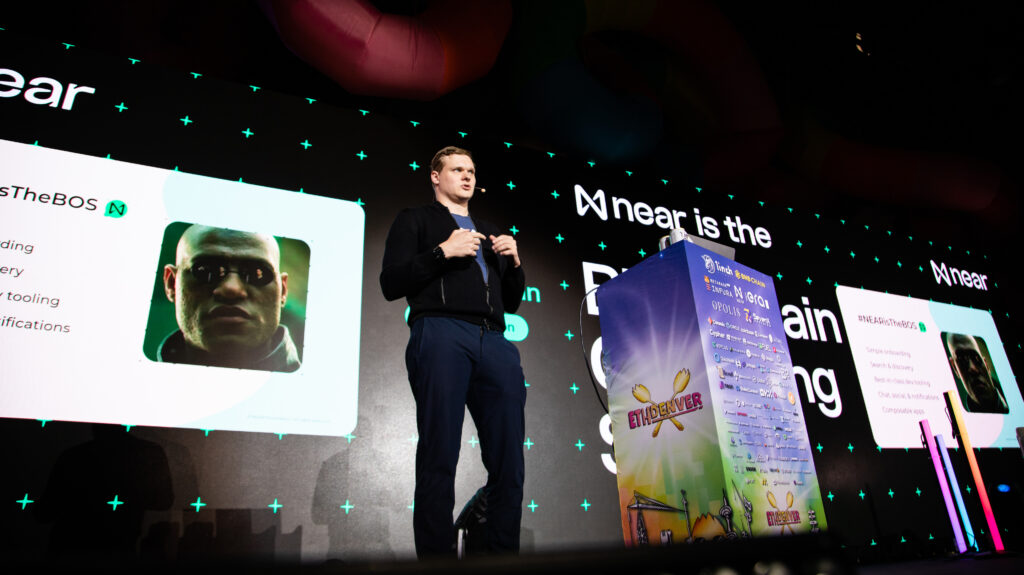
Near Day, the 1-day mini summit on all things Near, was jam-packed with the latest technological and protocol updates. Chief among them was the announcement of the Blockchain Operating System.
Things got started with a Regenerative Finance (ReFI) talk from Open Forest Protocol’s Frederic Fournier and Flow Carbon’s Phil Fogel. Later in the morning programme, OnMachina’s Polina Aladina and Mark Collier talked about building decentralized storage on Near. As a vital Near ecosystem project, it was great for the ETHDenver crowd to hear from OnMachina on Web3 storage.
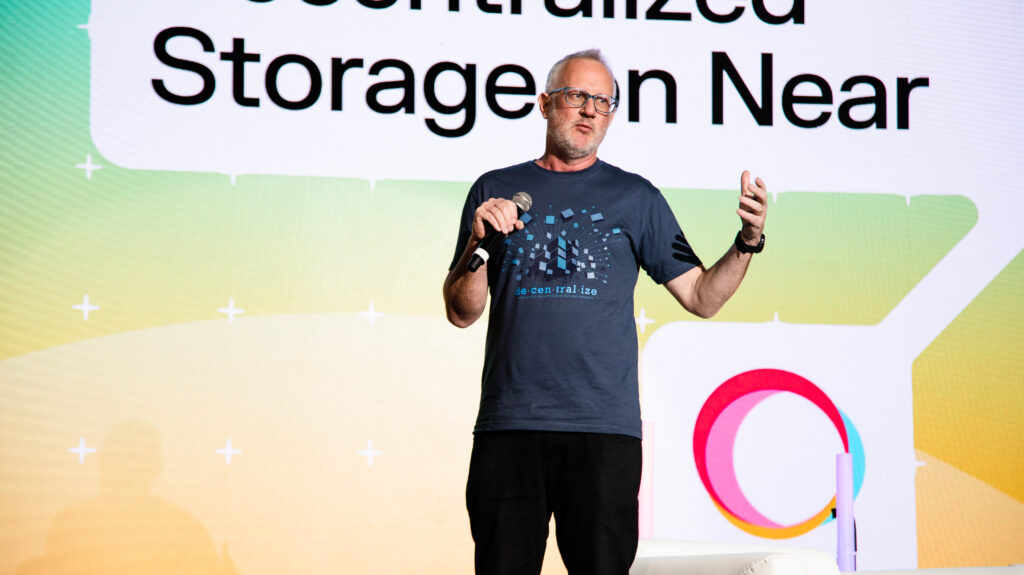
Keypom, which also recently launched on Near, got some much needed visibility at Near Day. In “Instant Crypto Experiences with Keypom”, Ben Kurrek and Matt Lockyer took the audience on a tour of their Web3 onboarding solution, in which users are given a special type of access key that can be used to experience a crypto application and later be turned into a wallet. (Read more about Keypom here.)
The morning programme also featured talks from Calimero Network’s Sandi Fatic on privacy and scaling with private sharding; Aurora Labs’ Alex Shevchenko on Containers, Aurora’s cloud computing solution for blockchains; Sweat Economy’s Oleg Fomenko on how to effectively onboard people from Web2 to Web3; and Near co-founder Alex Skidanov on how the future of AI will be decentralized.
In the afternoon, there were a range of talks, starting with Pagoda’s Max Zavershynskyi presentation on creating “high velocity developer communities” via Near DevGov DAO. But the big news on Near Day was the Blockchain Operating System talk from Near co-founder Illia Polosukhin. After Illia primed the audience, Pagoda’s Chief Product Officer Alex Chiocchi elaborated on how Blockchain Operating System will help in onboarding millions of users to Near, while Pagoda’s Bowen Wang detailed the protocol innovations powering the Blockchain Operating System.
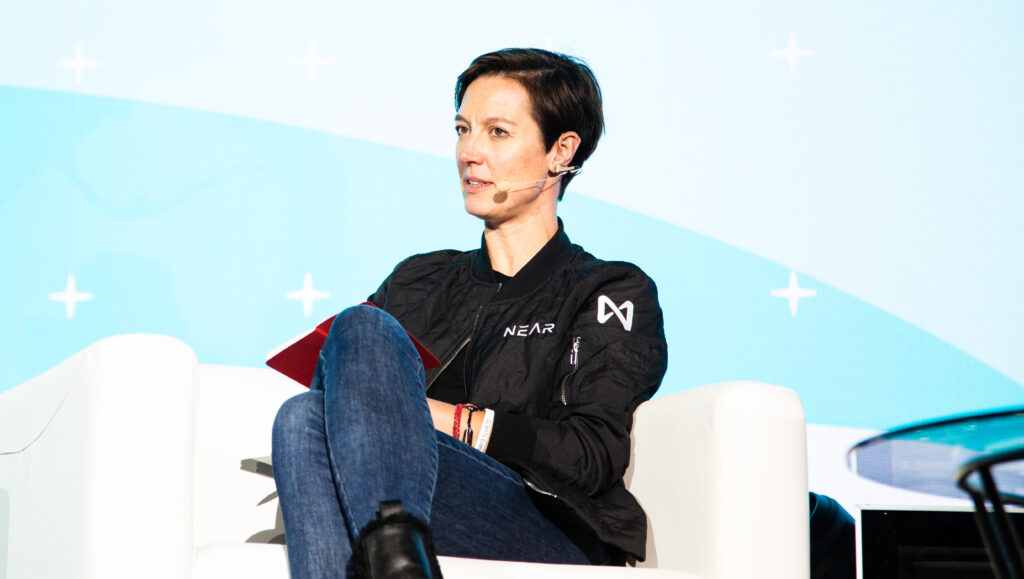
Near Foundation CEO Marieke Flament and Dragonfly Capital’s Haseeb Qureshi also talked about why the future remains bright for Web3 even during the crypto winter. There were also talks from Pagoda’s Pavel Kudinov on the Near data stack and Josh Ford on a fully decentralized Javascript.
Other topics included the building of infrastructure to onboard 1 billion users on Near, NFT infrastructure, a “DeFi survival kit” for the bear market, and the regulatory landscape in Web3.
Near speakers at ETHDenver
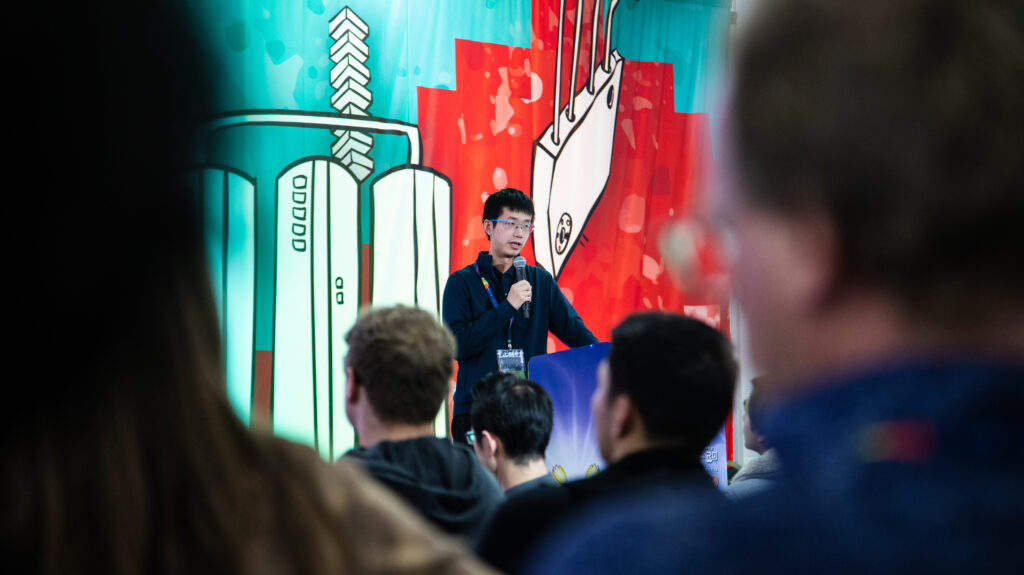
A number of speakers represented the Near ecosystem at ETHDenver talks. Topics included the Blockchain Operating System, sustainability, UX design, and more.
Aurora Labs’ Alex Shevchenko kicked things off with a presentation on Web3 infrastructure and scalability — specifically, how not to hack everything up in creating bridges. Alex also gave another talk on next generation user experience. Near Foundation CEO Marieke Flament delivered a talk on the three pillars of Web3 sustainability, while Proximity Labs’ Kendall Cole explored how Web3 can win in the DeFi battle against app stores.
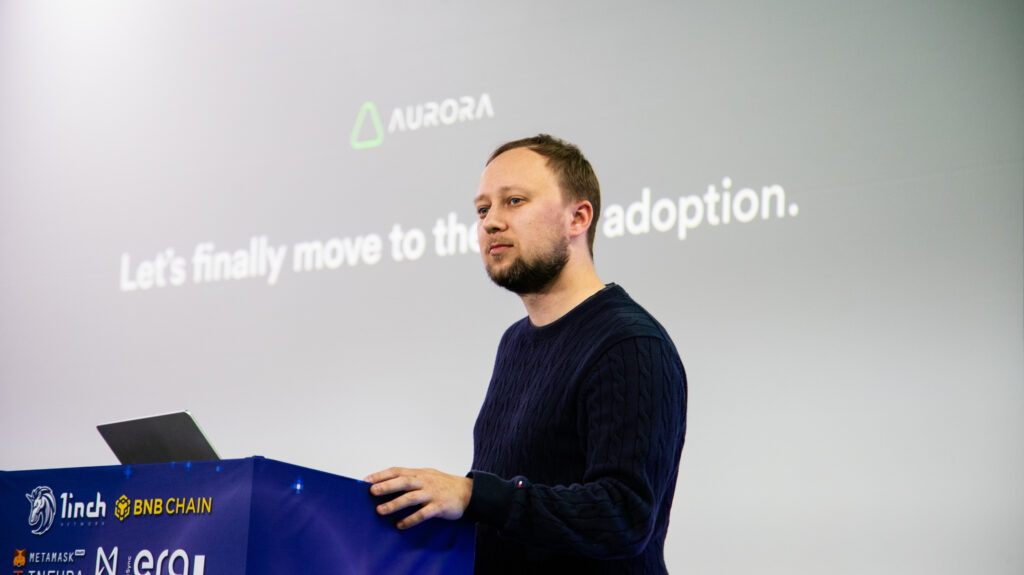
In separate talks, Illia Polosukhin and Pagoda’s Bowen Wang spoke to the ETHDenver audience about the Blockchain Operating System. While Bowen mapped out Near’s vision for Layer 1 Infrastructure, Illia talked about reinventing Web3 development with decentralized frontends and social networking.
Near Announcements
While the Near is the Blockchain Operating System announcement was the talk of ETHDenver, there were plenty of other announcements. Find the full run-down of Near ecosystem announcements here.
In other news, the Near ecosystem had two wins at ETHVC’s Startup Demo Day during ETHDenver — Niche Protocol, a Web3 social media platform, and Kino, a film financing platform.
Near announced today that it is becoming the Blockchain Operating System (BOS). The BOS is an industry-first category: a common layer for browsing and discovering open web experiences, compatible with any blockchain.
The Blockchain Operating System will make Near the entry point for the Open Web, for users and developers alike. And it will make both Web3 and Web2 easier than ever to access and navigate.
Becoming more than just a blockchain
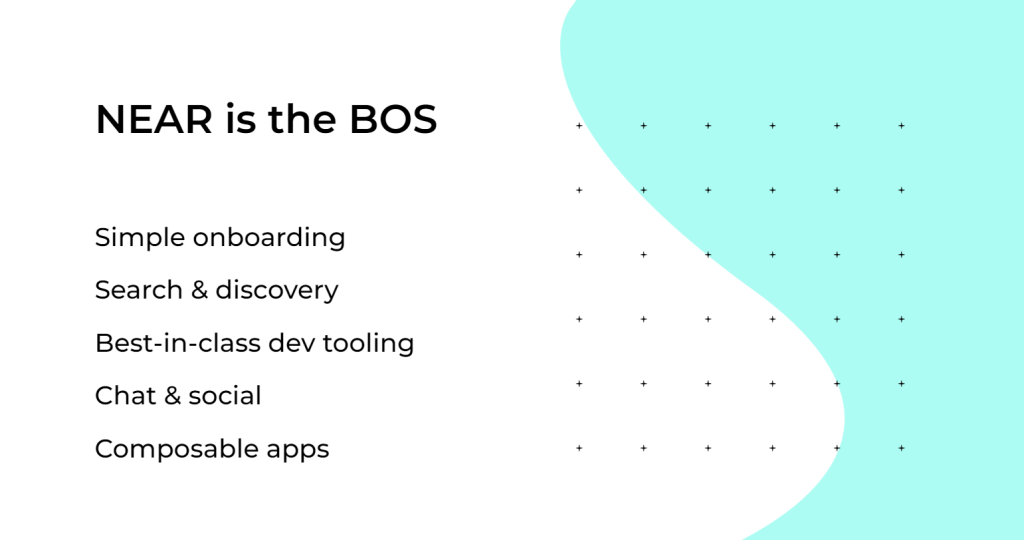
Since inception, Near’s mission has been to onboard 1 billion users to the Open Web. The first step in the journey was to focus on building a best in class L1 blockchain that was easy to build on and easy to use.
Near was designed to be simple, with a flexible account model and human readable accounts — any name a user wants instead of a string of letters and numbers. And with Near’s Nightshade sharding approach, the Near blockchain was designed to be infinitely scalable and secure. At the same time, Near concentrated on building out tooling to support builders developing on the protocol, including the JavaScript SDK that now gives 15 million developers access to building on Near.
This has created and sustained a thriving Near ecosystem with more than 23 million accounts and over a thousand project building, but these were only the first steps toward delivering the vision of Web3 to a mainstream audience.
Now, Near is building up the Web3 stack to integrate experiences from across the open web and streamline the discovery and onboarding experience for users and developers alike.
Enter Near: the Blockchain Operating System
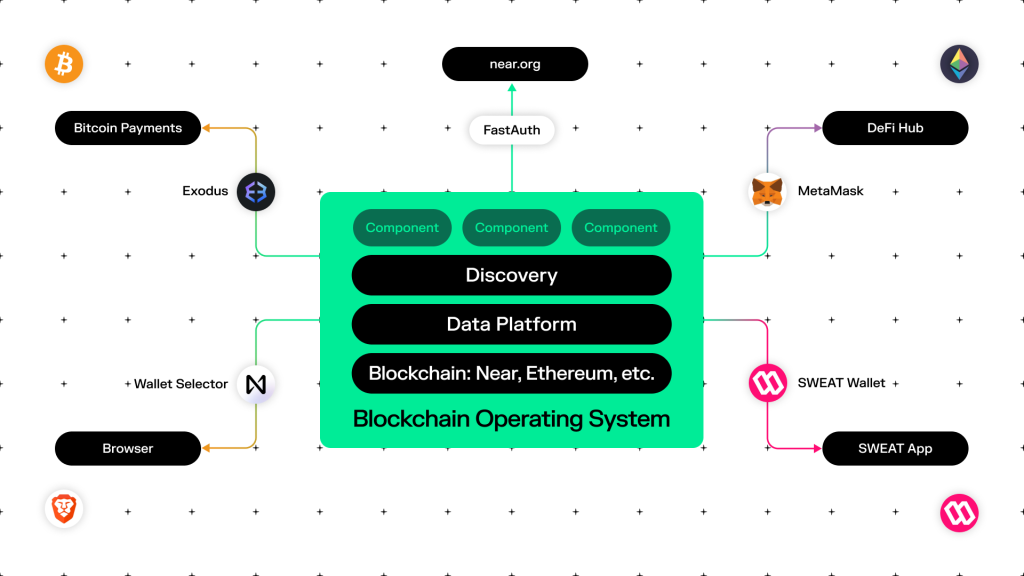
Today, Near is launching near.org — a composable frontend for Web3. It will allow end users to easily and frictionlessly discover all of Web3’s possibilities in one seamless experience. It will also empower developers to create and code interfaces in a single environment with the ability to fork a host of components to build apps faster, and more efficiently than ever before.
Anyone in the Open Web ecosystem can create their own frontends (i.e., their own versions of near.org), compatible with the blockchain of their choice. This means that builders from any ecosystem can create components in just a few lines of code, and take advantage of fast onboarding to help make new and custom Web3 experiences.
This is an industry first. With the addition of composable frontends to the tech stack, Near now becomes the Blockchain Operating System, allowing seamless, one-time onboarding and removing friction points like making accounts for every experience, while supercharging development from a collection of over 1,800 components.
Near.org is the first step in Near’s Blockchain Operating System journey. It’s the Alpha version, where builders can see the frontend come to life.
Try it out at near.org to experience the world’s first Blockchain Operating System — a revolutionary moment in Web3. If you’re a developer, see how easy it is to fork components and create new experiences. If you’re an end user, see how easy it is to explore Web3 experiences, social, and news all in one place.
The Blockchain Operating System is Near and it’s here. #NearistheBOS
